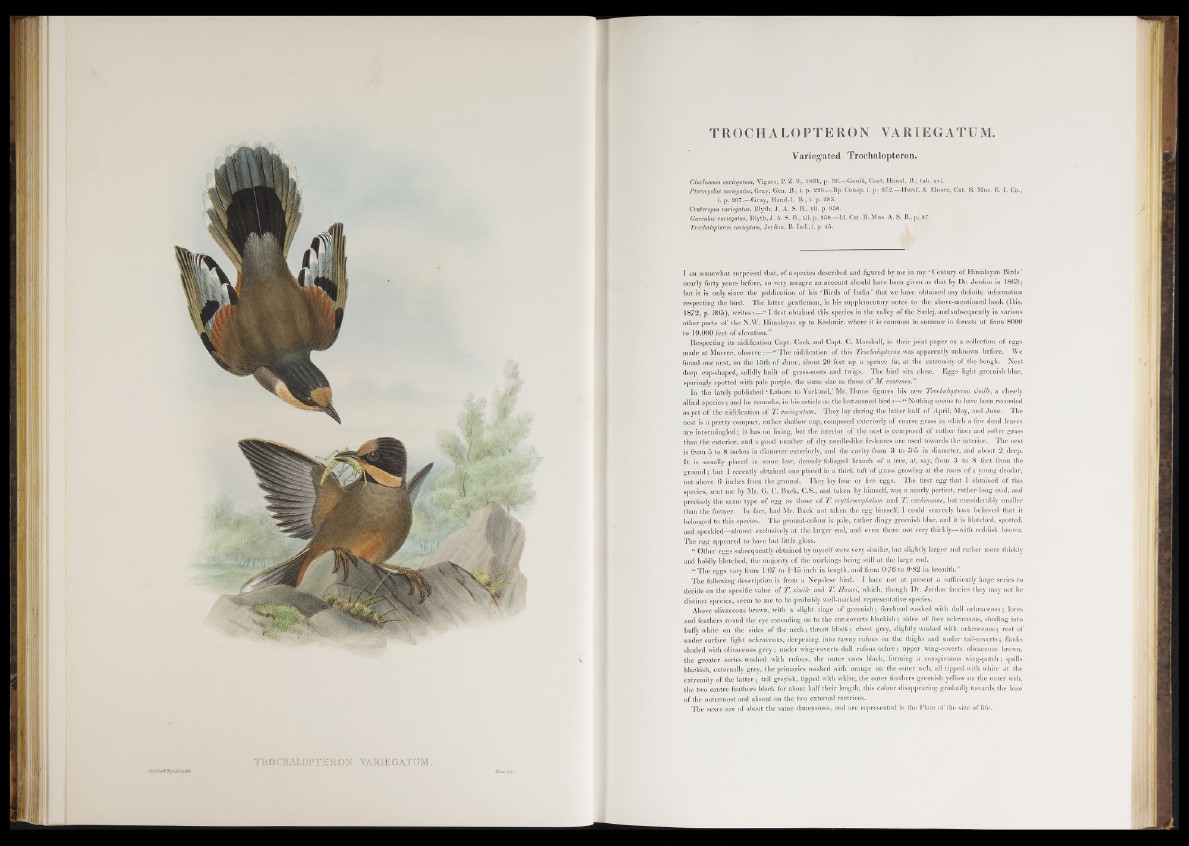
WS?
J&silá'&Wlíin'Mia'lak/
TRO CBALOPTERON VARIE GATUM.
TROCHALOPTERON YARIEGATUM.
Variegated Trochalopteron.
Cinclosotna variegatum, Vigors, P. Z. S., 1831, p. 56.—Gould, Cent. Himal. B., tab. xvi.
P ter ocy clus variegatus, Gray, Gen. B., i. p. 226.—Bp. Consp. i. p- 372.—Horsf. & Moore, Cat. B. Mus. E. I. Co.,
i. p. 207.—Gray, Hand-1. B., i. p. 283.
Crateropus variegatiis, Blyth, J. A. S. B., xii. p. 950.
Garridax variegatiis, Blyth, J. A. S. B., xii. p. 950.—Id. Cat. B. Mus. A. S. B., p. 97.
Trochalopteron variegtum, Jerdon, B. Ind., i. p. 45.
I am somewhat surprised that, o f a species described and figured by me in my ‘ Century o f Himalayan Birds ’
nearly forty years before, so very meagre an account should have been given as that by Dr. Jerdon in 1863;
but it is only since the publication.of his ‘Birds of In d ia’ that we have obtained any definite information
respecting the bird. The latter gentleman, in his supplementary notes to the above-mentioned book (Ibis,
1872, p. 305), writes 7“ I first obtained this species in the valley of the Sutlej, and subsequently in various
other parts o f the N.W. Himalayas up to Kashmir, where it is common in summer in forests at from 8000
to 10,000 feet of elevation.”
Respecting its nidification Capt. Cock and Capt. C. Marshall, in their joint paper on a collection of eggs
made at Murree, observe The nidification of this Trochalopteron was apparently unknown before. We
found one nest, on the 15th of June, about 20 feet up a spruce fir, at the extremity of the bough. Nest
deep cup-shaped, solidly built of grass-roots and twigs. The bird sits close. Eggs light greenish blue,
sparingly spotted with pale purple, the same size as those of M. castanea”
In the lately published ‘ Lahore to Yarkand,’ Mr. Hume figures his new Trochalopteron simile, a closely
allied species ; and he remarks, in his article on the last-named bird Nothing seems to have been recorded
as yet of the nidification of T. variegatum. They lay during the latter half of April, May, and June. The
nest is a pretty compact, rather shallow cup, composed exteriorly of coarse grass in which a few dead leaves
are intermingled ; it has no lining, but the interior of the nest is composed of rather finer and softer grass
than the exterior, and a good number of dry needle-like fir-leaves are used towards the interior. The nest
is from 5 to 8 inches in diameter exteriorly, and the cavity from 3 to 3*5 in diameter, and about 2 deep.
I t is usually placed in some low, densely foliaged branch of a tree, at, say, from 3 to 8 feet from the
ground ; but I recently obtained one placed in a thick tuft o f grass growing at the roots of a young deodar,
not above 6 inches from the ground. They lay four or five eggs. The first egg that I obtained o f this
species, sent me by Mr. G. C. Buck, C.S., and taken by himself, was a nearly perfect, rather long oval, and
precisely the same type of egg as those of T. erythrocephalum and T. cachinnans, hut considerably smaller
than the former. In fact, had Mr. Buck not taken the egg himself, I could scarcely have believed that it
belonged to this species. The ground-colour is pale, rather dingy greenish blue, and it is blotched, spotted,
and speckled—almost exclusively at the larger end, and even there not very thickly—with reddish brown.
The egg appeared to have but little gloss.
“ O ther eggs subsequently obtained by myself were very similar, but slightly larger and rather more thickly
and boldly blotched, the majority of the markings being still at the large end.
“ The eggs vary from l'O7 to 1*15 inch in length, and from 0 7 6 to 0*82 in breadth.”
The following description is from a Nepalese bird. I have not a t present a sufficiently large series to
decide on the specific value of T. simile and T. Humei, which, though Dr. Jerdon fancies they may not be
distinct species, seem to me to be probably well-marked representative species.
Above olivaceous brown, with a slight tinge of greenish ; forehead washed with dull ochraceous ; lores
and feathers round the eye extending on to the ear-coverts blackish ; sides o f face ochraceous, shading into
buffy white on the sides of the neck ; throat black ; chest grey, slightly washed with ochraceous ; rest of
under surface light ochraceous, deepening into tawny rufous on the thighs and under tail-coverts ; flanks
shaded with olivaceous grey ; under wing-coverts dull rufous ochre ; upper wing-coverts olivaceous brown,
the greater series washed with rufous, the outer ones black, forming a conspicuous wing-patch ; quills
blackish, externally grey, the primaries washed with orange on the outer web, all tipped with white at the
extremity of the latter ; tail greyish, tipped with white, the outer feathers greenish yellow on the outer web,
the two centre feathers black for about half their length, this colour disappearing gradually towards the base
of the outermost and absent on the two external rectrices.
The sexes are of about the same dimensions, and are represented in the Plate o f the size of life.